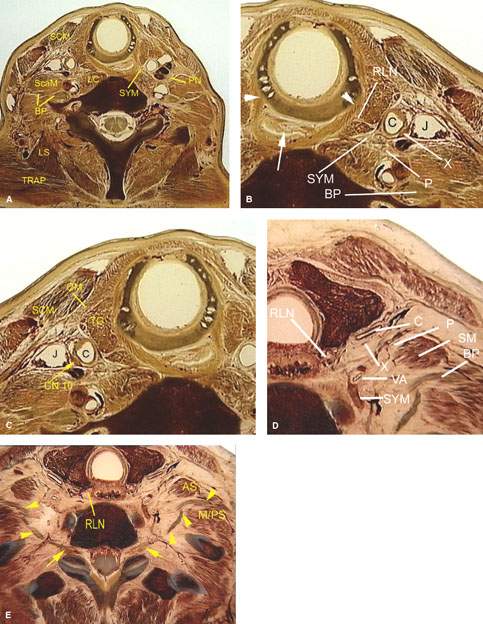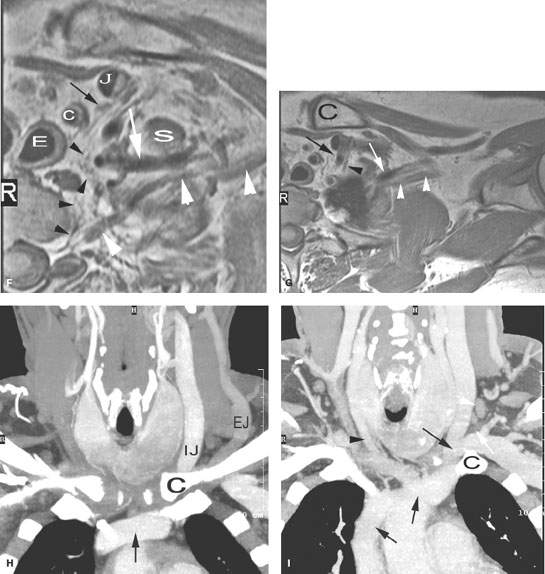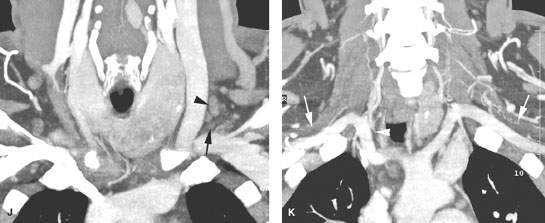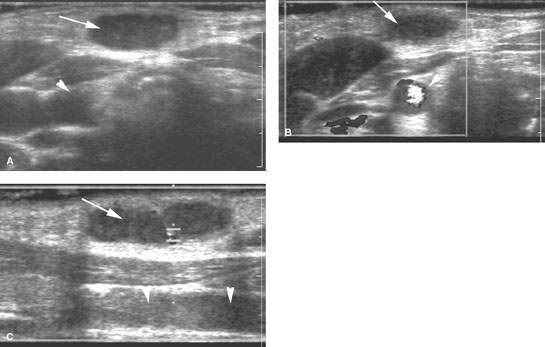CERVICOTHORACIC JUNCTION AND BRACHIAL PLEXUS CONDITIONS: GENERAL DIAGNOSTIC APPROACH
KEY POINTS
- The origin of a cervicothoracic junction condition is often not understood from the physical examination and may be threatening to one or more important and sometimes vital functions.
- Imaging can most often provide a very likely diagnosis.
- Imaging is critical to proper medical decision making beyond the diagnosis.
- Imaging-guided biopsy may be useful in more difficult diagnostic cases.
It is best to consider the compartment of origin as an initial step in the evaluation of a low neck and/or thoracic inlet mass or other condition. The visceral compartment remains the central compartment of orientation, as it is elsewhere in the neck, when dealing with this low neck/thoracic inlet and brachial plexus pathology. As such, it the logical beginning point for considering the source of a neck mass.
Except for the thyroid gland (Chapters 169–173), a palpable mass arising from the visceral compartment is relatively uncommon. A neck mass arising from the related retropharyngeal (retrovisceral) space in the low neck also accounts for a very small percentage of patients presenting with palpable or otherwise symptomatic thoracic inlet masses; those that do arise from this source are discussed in detail in Chapter 152. Masses that arise in the retropharyngeal space are almost by definition transcompartmental if they present as a neck mass. Transcompartmental thoracic inlet involvement can occur in deep neck infections and developmental masses such as venolymphatic malformations as well as more aggressive and/or advanced malignant tumors; thus, any strict compartmental or spatial approach is always an imperfect tool from the outset.
The majority of low neck/thoracic inlet conditions arise from the lateral or posterior compartments of the neck, and a few related important anatomic structures are reviewed for convenience in this chapter (Fig. 163.1). If not the source of pathology, the structures of those same compartments may be threatened by the pathologic process. The clavicle and sternum, especially the sternoclavicular joint, may also be the source of a mass.
The method of first considering a space or compartment of origin is therefore meant to serve only as a starting point and basic means of organization for the differential diagnosis and more importantly for clinical problem solving and disposition when confronted with a neck and/or thoracic inlet condition of uncertain etiology.
The reported imaging experience with many lesions arising within the thoracic inlet is largely anecdotal except for those of the thyroid gland and brachial plexus; the latter two are discussed in Chapters 169 through 173 and Chapters 164 through 167, respectively. One must be familiar with the full range of pathology possible because patients with cervicothoracic junction (CTJ) conditions of uncertain etiology sometimes present complex clinical problems and/or physical findings that can be greatly simplified by good-quality, well-interpreted images. Such imaging, sometimes combined with imaging-guided biopsy, most often leaves clinicians and patients with little doubt about the nature of the disease and the safest way to proceed to further histologic diagnosis and/or definitive treatment.
ANATOMIC CONSIDERATIONS IN DIFFERENTIAL DIAGNOSIS
Applied Anatomy: Cervicothoracic Junction, Thoracic Inlet, and Brachial Plexus
In the upper infrahyoid neck, the larynx and hypopharynx are the sole occupants of the visceral compartment, and that detailed anatomy is discussed in conjunction with those organs. In the low infrahyoid neck, the anatomy of the visceral compartment becomes very simple, composed essentially of two adjacent tubes—the airway and the esophagus—and the partially attached thyroid and parathyroid glands. The cricoid cartilage is its most prominent landmark and is easy to recognize as it surrounds the airway posteriorly since it is the only complete ring in the airway. It can be considered the starting point of the visceral compartment in the CTJ (Fig. 163.1). The cervical esophagus creates an oval structure posterior to the trachea in the midline. The thyroid and parathyroid glands also lie mainly at the level of the cricoid and below. The more detailed anatomy of these structures is also considered in conjunction with these specific organs.
The inferior thyroid arteries and veins can be seen on all of these examinations as they course through the fat pad between the posterior aspect of the thyroid and longus colli muscle and lateral to the esophagus. These tiny vessels mark the expected position of the parathyroid glands and the recurrent laryngeal nerve (Fig. 163.1). The latter are important considerations in possible vocal cord dysfunction that might arise from a mass or be a necessary result of surgical extirpation of a mass.
The fascia of the visceral compartment is derived from a splitting of the investing layer of deep cervical fascia interwoven with the coverings of the pharyngeal musculature. Laterally and posteriorly, it is not very resistant to the spread of pathologic processes. Numerous gaps and clefts are present in this fascial envelope for the passage of neurovascular bundles—at this level of the neck, those mainly being the brachial plexus and subclavian vessels (Fig. 163.1).
Anteriorly, the fasciae of the visceral compartment are tougher because of the pretracheal fascia (Figs. 149.1 and 149.2 and Chapter 149). The pretracheal fascia lies deep to the infrahyoid strap muscles and splits to enclose the thyroid gland, only adhering to the gland at the thyroid isthmus at about the level of the second through the fourth tracheal ring. The space formed between the pretracheal fascia and trachea allow for the sliding action necessary during swallowing and neck movement.
The other primary anatomic considerations, both as sources of pathology and possibly related dysfunction, include the vagus nerve as it enters the CTJ together with the common carotid artery and internal jugular vein (Fig. 163.1). The thoracic duct will frequently be visible at the left jugulosubclavian junction (Fig. 163.1). The inferior cervical (stellate ganglion) of the sympathetic trunk bears a constant relationship medial to the origin of the vertebral arteries (Fig. 163.1).
The brachial plexus bears a constant relationship posterior to the anterior scalene muscle in the posterior compartment, and the phrenic nerve (Fig. 163.1) lays on the belly of the anterior scalene muscle beneath the prevertebral fascia that envelopes the posterior compartment, with that fascia penetrated substantially by the trunks of the brachial plexus laterally (Fig. 163.1).



FIGURE 163.1. A: Anatomic whole organ section to demonstrate major muscle groups as landmarks and structures that mark the junction of low neck and the thoracic inlet, including the position of important nerves and nerve bundles in the neck and just above the thoracic inlet. Named major muscles include the sternocleidomastoid (SCM), levator scapulae (LS) muscle and trapezius (TRAP), and longus colli (LC). The scalene muscle group (ScaM) is an important landmark for the brachial plexus (BP) and the position of the phrenic nerve (PN). The carotid sheath is a useful landmark for identifying the position of the cervical sympathetic trunk (SYM). B, C: Anatomic whole organ sections to demonstrate important structures at the upper border of the low neck as identified by the esophageal verge (arrow in B) and its attachment to the lower aspect of the cricoid ring (arrowheads in B). The omohyoid muscle (OM) crosses the jugular vein at this position in the neck and can be seen distinctly from the sternocleidomastoid muscle (SCM) as another landmark between the mid and lower neck. (C, carotid artery; J, jugular vein; SYM, sympathetic plexus; RLN, recurrent laryngeal nerve; P, phrenic nerve; BP, brachial plexus; CN 10, vagus nerve.) D, E: Anatomic sections to correlate with the images seen in (F) and (G). The roots (arrows) and trunks (arrowheads) of the brachial plexus are shown in (E). (SYM, sympathetic plexus; RCN, recurrent laryngeal nerve; C, carotid artery; J, jugular vein; P, phrenic nerve; BP, brachial plexus; SM, anterior scalene muscle; M/PM, medial and posterior scalene muscles; VA, vertebral artery; CN 10, cranial nerve X.) F: Contrast-enhanced magnetic resonance image showing the anterior scalene muscle (S) as the major landmark for the brachial plexus. The subclavian artery lies just posterior (arrow). The roots and proximal trunks of the brachial plexus typically run posterior to the artery or lie posteriorly and superiorly as the vessels and nerves course in a tunnel within the scalene muscle group (arrowheads). The carotid (C) and jugular (J) mark the position of the vagus nerve (arrow), and the plexus of nerves that form the inferior sympathetic cervical ganglion (arrowheads) are medial to the vertebral artery origin. (E, esophagus.) G: An image made just superior to that seen in (F) to demonstrate that the brachial plexus is typically seen segmentally because of its oblique course relative to the axial plane of the section. Here, the roots are transitioning to trunks (white arrowheads) as they pass into the beginning of the axillary sheath. The subclavian artery remains a reliable anatomic landmark (white arrow) for the plexus. The vagus nerve or thoracic duct (black arrowhead) lies posterior to the jugulosubclavian junction (black arrow). H–K: Reformatted contrast-enhanced computed tomography images from anterior to posterior through the thoracic inlet highlighting some basic anatomic considerations at this transition from the neck to the chest. In (H), the brachiocephalic vein (arrow) is shown as a good landmark for determining whether a lesion traversing the thoracic inlet will require a surgical approach that requires splitting of the sternum. In general, masses that remain above the vein do not require splitting of the sternum for adequate surgical exposure. Note that there is a confluence between the internal and external jugular vein, usually just before they enter the subclavian vein. (C, clavicle; IJ, internal jugular vein; EJ, external jugular vein.) In (I), the jugulosubclavian junction is an important landmark at the thoracic inlet. Note how it is contiguous with the brachiocephalic vein and superior vena cava (arrows). This junction lies just behind the clavicle (C) and also marks the approximate position of the thoracic duct on the left. Also note the origin of the common carotid artery from the brachiocephalic artery (arrowhead) at this level. In (J), an image very near the jugulosubclavian junction shows the thoracic duct as it joins the subclavian vein (arrow) and relationship of the scalene lymph nodes to the thoracic duct at this level of transition from the neck to the chest (arrowhead). In (K), the most posterior section shows the relationship of the brachial plexus trunks to the subclavian arteries. Note on the right the origin of the vertebral artery from the subclavian artery. The arrowhead shows the expected position of the inferior cervical ganglion. The proximity of these structures to the lung apex shows how such tumors easily invade the critical neurovascular structures in this region.
IMAGING APPROACH
Techniques and Relevant Aspects
The techniques for computed tomography (CT) studies of the infrahyoid neck and CTJ and brachial plexus for various clinical situations are presented in Appendix A. The rationale for these protocols is presented specifically in Chapter 149 and more generally in Chapter 2.
The techniques for magnetic resonance (MR) studies of the infrahyoid neck, CTJ, and brachial plexus for various clinical situations are presented in Appendix B. The rationale for these protocols is presented specifically in Chapter 149 and more generally in Chapter 3.
Standard ultrasound (US) imaging and flow-related techniques are used with transducers appropriate for the depth of penetration required. This is discussed in more detail in Chapter 149 and generally in Chapter 3.
Catheter angiography is obviated in most cases when high-quality CT and MR angiography is available; catheter angiography is now most commonly used as a prelude to endovascular procedures once the diagnosis has been established by noninvasive advanced imaging studies.
Pros and Cons
The relative value of CT, MR, and US at the CTJ can be considered in relationship to whether the pathology is likely to be of thyroid origin (Fig. 150.1A,B) and whether the brachial plexus and neural axis is of prime interest at the outset based on clinical information (Fig. 150.1C). Magnetic resonance imaging (MRI) is most appropriate for disorders of the spine and neural axis. This includes most patients with nontraumatic brachial plexopathy. CT is more efficient for study of neurologic deficits related to the vagus and recurrent laryngeal nerves (Chapter 138), phrenic nerve, or cervical sympathetic plexus (Chapter 141) because of the large area of coverage, vascular detail, and bone detail required. Certainly, MRI can be held in close reserve for these latter indications or used primarily if preferred.
This chapter considers the basic approach to patients who present for imaging of the neck and have a palpable and/or visible mass and/or signs and symptoms referable to the structures in this anatomic zone. Imaging studies in this clinical setting must be integrated with proper clinical triage. This produces the most efficacious use of imaging evaluation.
Triage may first include study of pathologic results from needle sampling of the mass. Imaging guidance may be sometimes necessary for such sampling, especially if the mass may be vascular or a nearby vascular structure is at risk during biopsy. If a biopsy is performed prior to imaging, the person performing the biopsy must be sure that the mass is not a vascular lesion and that the chosen method will not injure a major vessel. If a lesion is either pulsatile or potentially related to the carotid artery or jugular vein, then imaging, perhaps as simple as a localized US examination (Fig. 163.2), should precede biopsy and perhaps the same US examination used to direct such sampling. US is excellent for prebiopsy screening and biopsy guidance in the hands of an experienced operator. US is otherwise not used for definitive evaluation of visceral compartment and retropharyngeal space masses except for masses that are very likely of thyroid origin. Imaging-guided biopsy, if not by US, is by CT for ease, speed, and simplicity.
The clinical situation and biopsy results often dictate whether further imaging is necessary and will also direct a preference for CT or MRI. Nondiagnostic biopsies make further imaging necessary in the vast majority of cases. If the biopsy and/or clinical situation strongly suggest a diagnosis other than metastatic cancer, lymphoma, or thyroid cancer, then the choice of MRI or CT is determined mainly by clinical factors. For instance, in most cases, a suspected slow-flow vascular malformation is probably evaluated more simply and somewhat better studied by MR than CT (Fig. 150.1E).
DIFFERENTIAL DIAGNOSIS OF CERVICOTHORACIC JUNCTION CONDITIONS
The origin of masses in the cervicothoracic junction can be thought in terms of frequency of occurrence, neck level, anatomic site of origin, and/or etiologic categorization. The following approach is based mainly on anatomy and frequency of occurrence, with some comments based on etiologic considerations, such as developmental origins, as appropriate.
Clinical Presentation
The primary presentation for the purpose of this discussion is that of a neck mass of uncertain etiology. If bilateral, the masses may represent a systemic disease such as lymphoma (Fig. 163.3A). There may be associated pain, dysphagia, odynophagia, or dysphonia (Fig. 163.3A). Airway compression is possible. Occasionally, there will be a history of the mass changing in size, sometimes intermittently.
Tenderness and fever and associated generalized swelling may be present and are much more likely in inflammatory conditions (Fig. 163.4). Benign and vascular-related masses may be firm to compressible and/or pulsatile (Figs. 163.2, 163.5, and 163.6). Vascular conditions can also produce generalized swelling and evidence of ischemia. Masses may feel obviously cystic to palpation.
Neurologic dysfunction (Figs. 163.3A and 163.5) may be due to involvement of the brachial plexus, cervical sympathetics, vagus nerve, recurrent laryngeal nerves and phrenic nerve.

FIGURE 163.2. A patient presenting with a pulsatile paramedian low neck mass. This ultrasound examination shows the cystic-appearing mass in the transverse section in (A) (arrow) and its relationship to the common carotid artery (arrowhead). The Doppler study in (B) in the transverse plane shows that the pulsations felt over the mass was transmitted from the carotid artery and that the mass itself has no vascularity. This is confirmed in the sagittal view in (C), which shows the mass to be somewhat oblong. This proved to be a thymic cyst.
Stay updated, free articles. Join our Telegram channel

Full access? Get Clinical Tree








